Magnolia trees are renowned for their breathtaking flowers and unique characteristics.
However, because there are so many different types of trees with many changing dramatically from season to season, it’s no wonder that proper tree identification can be difficult.
Fear not. When it comes to magnolia trees, learning to identify them really isn’t that hard if you know what to look for.
This guide will walk you through the key characteristics of magnolia trees from their leaves and flowers to their bark and branching patterns, helping you differentiate between various types and species.
Key Takeaways
- Examine the leaves’ size, shape, and color. Evergreen magnolias typically have glossy, dark green leaves, while deciduous ones might have softer, lighter leaves.
- Pay attention to the color, size, and shape of the flowers. Some magnolias, like the Saucer magnolia, have large, showy blossoms, while others, like the Star magnolia, have more delicate blooms.
- Note the texture and color of the bark. Young magnolias might have smoother bark that becomes more textured as they mature.
- Consider where the tree is growing. Different magnolia species are native to specific regions, so knowing the geographic location can help narrow down the possibilities.
Home gardeners are often full of questions and concerns about their magnolia trees, so rest assured that you’re not alone. Be sure to check with my comprehensive guide, Magnolia Tree Questions, for the answers you need.
Magnolia Tree Identification
A magnolia tree is a botanical marvel that exudes elegance and charm. These trees are celebrated for their captivating beauty and distinctive characteristics.
With glossy leaves and a unique branching structure, magnolia trees stand out in various landscapes. Their remarkable flowers, often large and fragrant, steal the spotlight during their blooming seasons.
From the grandeur of evergreen varieties like the Southern magnolia with its iconic creamy white blossoms to the enchanting Saucer magnolia that graces gardens with its vibrant, saucer-shaped flowers, magnolia trees offer a sensory feast.
Evergreen Magnolia vs. Deciduous Magnolia
Evergreen magnolia trees maintain their dark green leaves throughout the year.
These glossy, leathery leaves contribute to the tree’s overall elegance, even in the winter months.
The Southern magnolia (Magnolia grandiflora) is an iconic example of this category with its large size, fragrant creamy-white flowers, and glossy foliage.
It’s a staple in many landscapes and is commonly associated with the southern United States.
Deciduous magnolia trees, on the other hand, undergo seasonal leaf changes, shedding their leaves in the fall.
These trees often showcase their captivating flowers on bare branches in early spring, making their blooms all the more striking against the backdrop of awakening nature.
The Saucer magnolia (Magnolia × soulangiana) is a well-known deciduous magnolia variety, celebrated for its vibrant, saucer-shaped flowers that emerge before its leaves, adding a burst of color to gardens in spring.
Magnolia Tree Shape & Size
Magnolia trees exhibit a diverse range of shapes and sizes that contribute to their distinctive presence in various landscapes.
The shape of a magnolia tree can vary from pyramidal to rounded, with the size influenced by factors like the species and growing conditions.
Evergreen magnolia trees often take on a pyramidal or conical shape with a strong central leader and branches that radiate outward.
The Southern magnolia, for instance, typically stands as a grand, upright evergreen tree with a conical crown.
However, it’s important to note that pruning practices can influence the natural shape of the tree. Regular pruning might result in a more compact or even multi-trunked form.
Deciduous magnolia trees also showcase varying shapes.
The Saucer magnolia for instance, often grows as a multi-stemmed large shrub or small tree with a rounded canopy. Again, pruning can significantly alter this natural shape.
When it comes to size, magnolia trees span a wide range.
Some, like the Star magnolia (Magnolia stellata), are relatively compact and suitable for smaller landscapes, reaching heights of around 10 to 15 feet.
Others, like the Southern magnolia, can become towering giants, soaring to heights of 60 to 80 feet or more under optimal conditions.
Magnolia Tree Flowers

Magnolia tree flowers are a true marvel, drawing admirers with their captivating beauty and unique features.
These flowers are often large and composed of numerous petals in pink, purple, white, or yellow, creating an exquisite display of nature’s artistry.
In terms of petal count, magnolia flowers can have varying numbers. Some, like the Star magnolia, possess multiple narrow petals that give them a star-like appearance.
Others, such as the Saucer magnolia, may have a more substantial number of petals in their blooms, contributing to their fullness and allure.
The size of magnolia flowers also varies between species.
For instance, the Lily magnolia (Magnolia liliflora) produces medium-sized flowers, while the Southern magnolia features large, fragrant blossoms that can reach up to 12 inches in diameter.
The timing of blooming is another distinguishing feature. Many deciduous magnolias burst into bloom in early spring before their leaves emerge.
This early flowering habit adds to their visual impact as the blossoms stand out against the backdrop of awakening landscapes.
Magnolia Tree Leaves
The leaves of magnolia trees are not only beautiful but also hold key clues for identification.
Leaf characteristics can vary widely between evergreen and deciduous magnolias as well as among different species within each category.
Evergreen Magnolia Leaves

Evergreen magnolias, such as the Southern magnolia, boast dark green leaves with a glossy sheen and coppery-brown undersides.
These leaves are typically leathery and elliptical in shape, offering a lush backdrop throughout the year.
One distinct feature to look for in evergreen magnolia leaves is the presence of a prominent midrib, which runs down the center of the leaf.
Veins branch out from the midrib in a graceful, arching pattern. This intricate veining adds to the elegance of the leaves and can aid in identification.
The Sweetbay magnolia (Magnolia virginiana), another evergreen variety, showcases leaves with a lighter shade of green, creating a delicate contrast.
These leaves tend to be more lance-shaped and emit a lemony fragrance when crushed.
Similarly, the Lily magnolia (Magnolia liliflora) presents elongated leaves with visible veins that contribute to its distinctive appearance.
Deciduous Magnolia Leaves
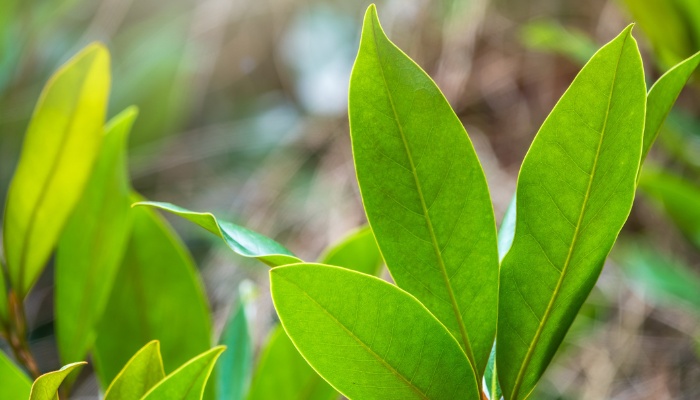
Deciduous magnolias, like the Saucer magnolia, present a different leaf experience. Their leaves tend to be broader and lighter green in color compared to their evergreen counterparts.
The veins on deciduous magnolia leaves are still prominent but typically exhibit a more intricate network pattern rather than the linear arrangement seen in evergreens.
As these magnolias shed their leaves in the fall, you’ll witness the transformation of the landscape as their branching structure is revealed.
Magnolia Tree Seed Pods

Seed pods are a crucial element in the identification of magnolia trees, offering distinctive traits that vary among different species and aiding in their classification.
Evergreen Magnolia Seed Pods
Evergreen magnolias, including the Southern magnolia, develop elongated seed pods that are often cone-shaped.
These pods, covered in reddish-brown scales, can grow to several inches in length.
Upon maturity, they release bright red seeds that attract various wildlife, contributing to the ecosystem.
These seed pods can hang from the branches, offering a unique visual element that adds to the tree’s overall appeal.
Deciduous Magnolia Seed Pods
Deciduous magnolias, like the Cucumber magnolia (Magnolia acuminata), produce intriguing cone-like seed pods that undergo a remarkable transformation as they develop.
Starting as green structures, these pods gradually mature to a vivid red or pink hue, creating a striking contrast against the tree’s branches.
The surface of these pods may display a bumpy texture, further distinguishing them from evergreen varieties.
Magnolia Tree Bark & Branching
Examining the bark and branching patterns of magnolia trees is a significant aspect of identification, offering insights into their overall character and distinguishing features.
Both evergreen and deciduous magnolias exhibit unique bark textures and branching arrangements that contribute to their visual appeal.
Evergreen Magnolia Bark & Branching
Evergreen magnolias like the Southern magnolia boast smooth and often grayish-brown bark when young, gradually developing shallow furrows as they mature.
Their branches tend to be sturdy and well-spaced, creating a distinctive layered appearance. These branches often spread horizontally, contributing to the tree’s symmetrical and pyramid-like shape.
The dark green, leathery leaves densely cover the branches, providing a lush, year-round canopy that adds to the tree’s regal presence.
Deciduous Magnolia Bark & Branching
Deciduous magnolias showcase a different bark and branching pattern. Young deciduous magnolias often have smooth bark that gradually becomes furrowed and textured as the tree ages.
Their branching tends to be more open and irregular with branches spreading in various directions.
This branching arrangement, especially noticeable in the winter when leaves have fallen, contributes to the tree’s picturesque silhouette.
Seasonal Changes
Understanding how magnolia trees transition throughout the seasons is integral to their identification and appreciation.
Evergreen Magnolia Seasonal Changes
Evergreen magnolias maintain their vibrant green foliage year-round, offering a consistent presence in the landscape.
However, even within this evergreen category, seasonal changes occur in the form of new growth and the periodic shedding of older leaves.
In spring, these magnolias produce new leaves and often display a flush of new growth. Over time, older leaves may turn a slightly darker shade, creating a subtle blend of hues within the canopy.
While the leaves themselves persist, the evergreen magnolia’s transition is marked by the emergence of its iconic fragrant flowers.
Deciduous Magnolia Seasonal Changes
Deciduous magnolias undergo more dramatic seasonal changes.
In the spring, deciduous magnolias burst into bloom before their leaves emerge, presenting a stunning spectacle of colorful flowers against bare branches.
As the weather warms, the leaves unfurl, forming a lush canopy that provides shade and contributes to the overall character of the tree.
In the fall, these leaves transform into brilliant shades of yellow, orange, and red before they drop, revealing the intricate branching structure that adds visual interest to the winter landscape.
Geographic Distribution of Magnolia Varieties
Several magnolia varieties are native to the United States.
In the realm of evergreen magnolias, the Southern magnolia stands as a symbol of the southeastern United States, gracing regions from Virginia to Florida and extending westward to Texas. It thrives in USDA Hardiness Zones 7 to 9.
The Sweetbay magnolia is a native evergreen variety found along the eastern coast of the U.S. from the Great Lakes region down to Florida.
Often seen in wetlands and coastal areas, the Sweetbay magnolia tree adds its unique lemon-scented flowers and distinct foliage to the natural tapestry. It can flourish in USDA Hardiness Zones 5 to 10.
For deciduous magnolias, the native lineup features the Cucumber tree (Magnolia acuminata), which finds its home in the eastern United States.
This magnolia variety graces regions ranging from the Great Lakes area down to the southern reaches of the Appalachian Mountains. It thrives in USDA Hardiness Zones 4 to 8.
Another standout is the Umbrella magnolia (Magnolia tripetala), thriving in the southeastern U.S., particularly in the Appalachian Mountains. It grows well in USDA Hardiness Zones 6 to 9.
Lastly, the Bigleaf Magnolia (Magnolia macrophylla) stands tall as a native treasure of the southeastern United States, captivating with its grand leaves and striking blossoms. It flourishes in USDA Hardiness Zones 6 to 9.
Common Types of Magnolia Trees
Magnolia trees encompass a captivating array of species, varieties, and cultivars, each possessing unique features that set them apart.
Southern Magnolia Tree (Magnolia grandiflora)
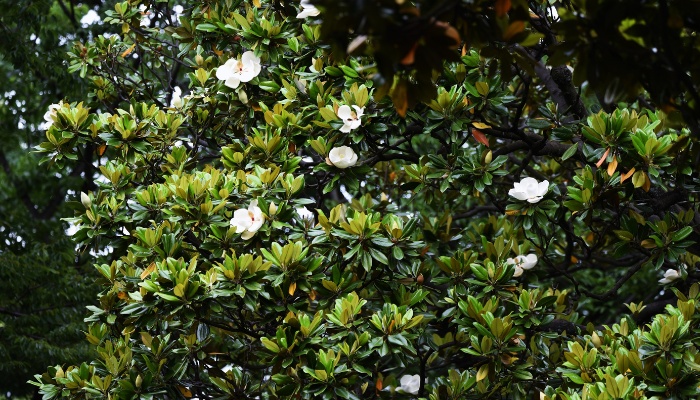
The Southern magnolia is an evergreen giant known for its imposing presence and captivating fragrance.
Its lustrous, leathery leaves are glossy dark green on top and velvety brown underneath, creating a striking contrast.
Its enormous, fragrant white flowers bloom in late spring and intermittently through summer, often reaching a foot in diameter.
This magnolia’s grandeur and unmistakable fragrance make it a beloved symbol of the American South.
Teddy Bear Magnolia Tree (Magnolia grandiflora ‘Teddy Bear’)
The Teddy Bear magnolia, a compact form of the Southern magnolia, is a smaller treasure that embodies elegance on a smaller scale.
Its rounded leaves possess the same glossy green charm as its parent species, and while it may reach only about 20 feet in height, it doesn’t compromise on beauty.
Its manageable size makes it an excellent choice for smaller landscapes or as specimen trees and shrubs in tighter spaces.
Saucer Magnolia Tree (Magnolia × soulangiana)
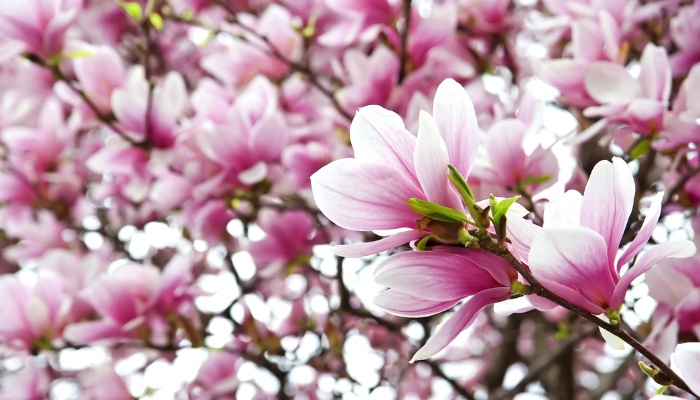
The Saucer magnolia is a deciduous delight that ushers in spring with a breathtaking display of flowers.
Its large, saucer-shaped blossoms, often pink, white, or a blend of both, cover the bare branches before the leaves emerge.
The blooms exude elegance and charm, creating a visually stunning scene against the awakening landscape.
As the seasons progress, the Saucer magnolia’s leaves unfurl, offering a lush canopy that complements its earlier floral extravaganza.
Jane Magnolia Tree (Magnolia ‘Jane’)
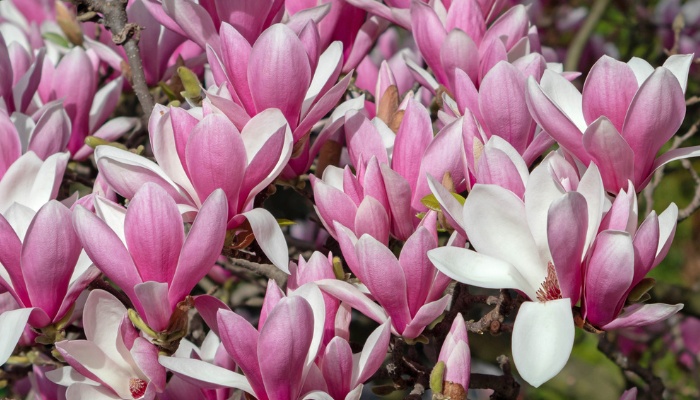
The Jane magnolia is a deciduous tree that graces gardens with its vibrant flowers. Its petals, a delightful shade of purplish-red, emerge before its leaves, resulting in a captivating burst of color.
The Jane magnolia’s compact size and bushy form make it an excellent choice for urban gardens and smaller spaces. Its ability to thrive in slightly colder climates adds to its popularity.
Trees Similar to Magnolia
There are several trees that could easily be mistaken for magnolia trees, especially when in full bloom. Upon close observation, however, you can quickly tell the difference.
Camellia

The camellia is renowned for its stunning, waxy flowers that burst forth in a variety of colors, from pristine white to vibrant shades of pink and red.
Much like magnolias, camellias often bloom in early spring, adding a burst of color to the landscape.
Their glossy, evergreen foliage provides a year-round backdrop of deep green that highlights the blossoms.
With different varieties offering single or double-petaled flowers, camellias stand as a captivating alternative for those seeking magnolia-like elegance.
Dogwood
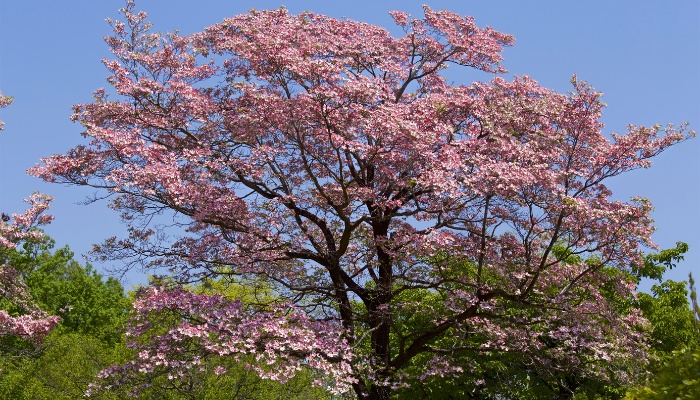
The dogwood tree, particularly the Eastern dogwood (Cornus florida), captivates with its delicate blossoms and picturesque structure.
In spring, its clusters of four-petaled flowers create a mesmerizing display against its bare branches.
The dogwood’s foliage transitions through the seasons, turning vibrant shades of red in the fall.
Much like magnolias, the dogwood’s enchanting blooms and ornamental value make it a sought-after addition to gardens and landscapes.
Flowering Cherry
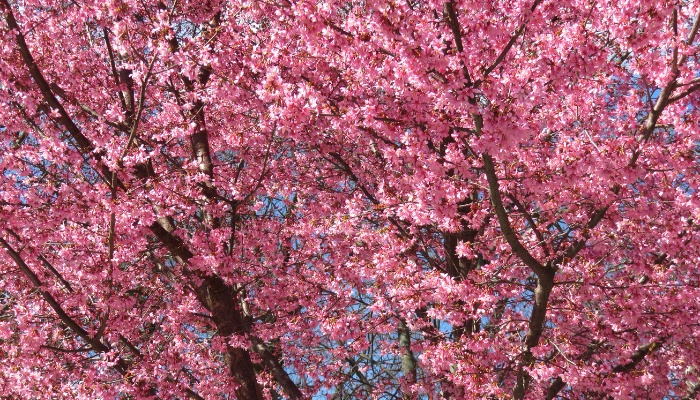
Flowering cherry trees, with their abundant and showy blooms, echo the allure of magnolia flowers and can look quite similar in early spring.
These trees are known for their breathtaking display of blossoms in various hues, including pink, white, and even shades of red.
As spring arrives, these cherry trees transform with cascades of petals, adding a touch of elegance to gardens and streets.
Chinese Sweetshrub

The Chinese sweetshrub (Calycanthus chinensis) features unique flowers that emit a delightful fruity fragrance. It is because of these flowers that the bush can be mistaken for a small magnolia.
Much like magnolia blossoms, the sweetshrub’s flowers possess a distinctive charm, featuring layers of petals in shades of white with a blush of pink.
Frequently Asked Questions
How Many Types of Magnolia Trees Are There?
There are approximately 125 species, varieties, and cultivars of magnolia. These variations range from grand evergreens like the Southern magnolia to the delicate elegance of the Star magnolia.
Each type possesses its own unique characteristics, creating a captivating spectrum of magnolia diversity.
What Is the Most Common Magnolia Tree?
One of the most widely recognized and cherished magnolia trees is the Southern magnolia.
With its glossy leaves, fragrant white flowers, and imposing presence, this evergreen magnificent magnolia has become an iconic symbol of the American South.
Its popularity is a testament to its timeless elegance and cultural significance.
Do All Magnolia Trees Bloom?
Yes, the majority of magnolia trees, whether trees or shrubs, are known for their exquisite blooms.
However, the timing, color, and size of the blooms can vary significantly between different magnolia species and varieties.
While some magnolias burst into showy blossoms in early spring, others may produce more modest flowers.
It’s this diversity in flowering patterns that contributes to the allure of magnolia trees.
How Can I Tell What Kind of Magnolia Tree I Have?
Identifying a magnolia tree involves a combination of factors, including leaf characteristics, flower appearance, bark texture, and geographic location.
By closely observing features such as leaf shape, color, and veining, examining flower size and color, and noting the tree’s natural habitat, you can begin to narrow down the possibilities and determine the specific type of magnolia tree you have encountered.
Utilizing field guides, botanical resources, and expert advice can further refine your identification skills.
Enjoy Using This Identification Guide
Identifying magnolia trees can be a rewarding endeavor, allowing you to appreciate the diverse beauty of these trees.
By examining characteristics such as leaves, flowers, bark, and size, you can correctly identify a magnolia and distinguish between various types of magnolia trees.
With a little practice, you’ll soon have no trouble at all determining which trees are indeed magnolias and which are similar look-alikes.
Eager to learn more about magnolia trees? Be sure to read these information-packed guides next:
- Can You Bonsai a Magnolia Tree? Magnolia Bonsai Care Guide
- Do Magnolia Tree Roots Cause Problems? What To Be Aware Of
